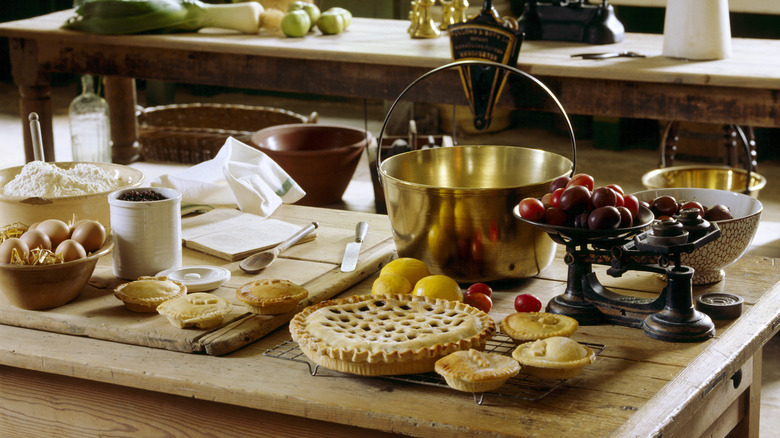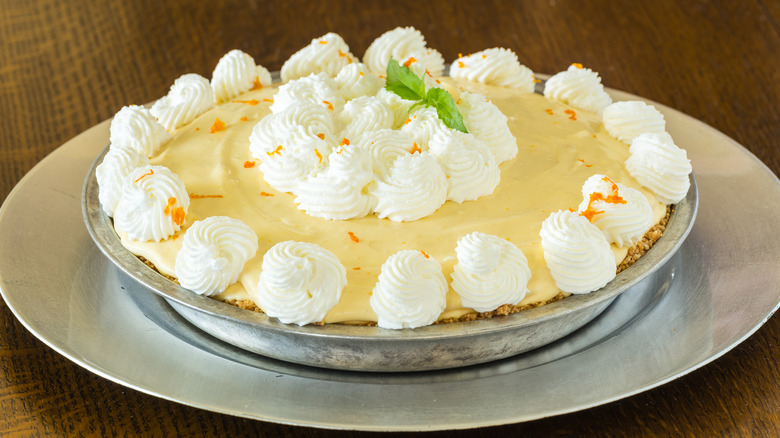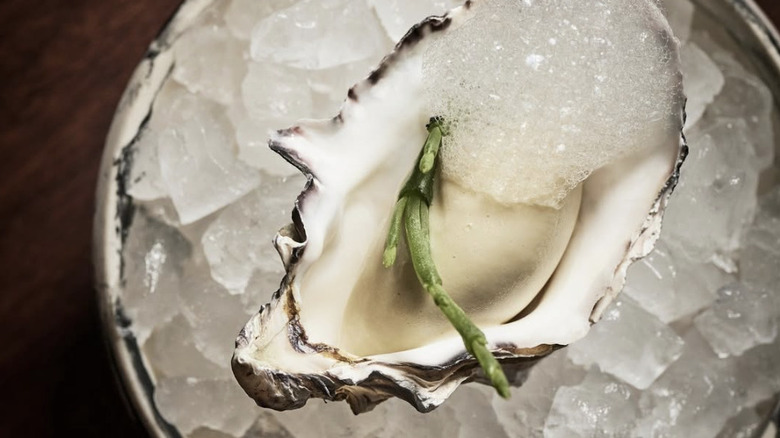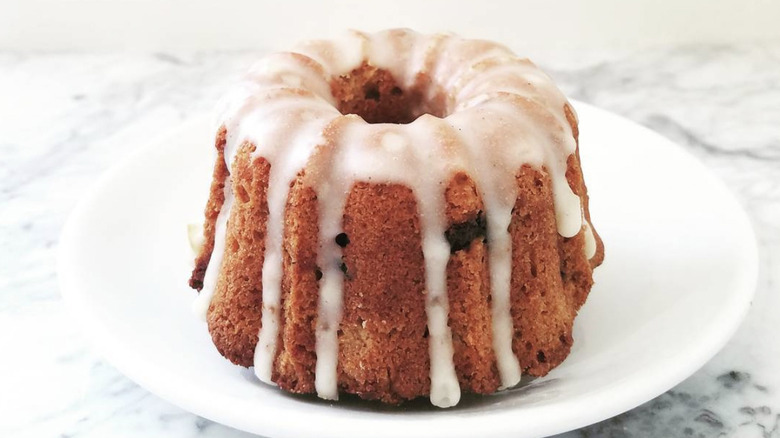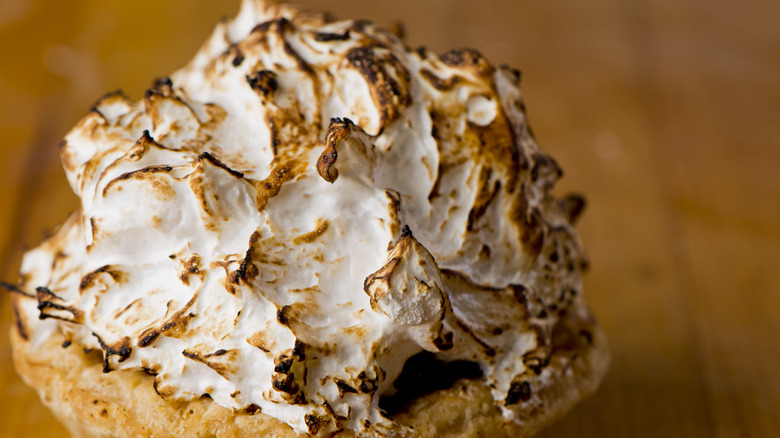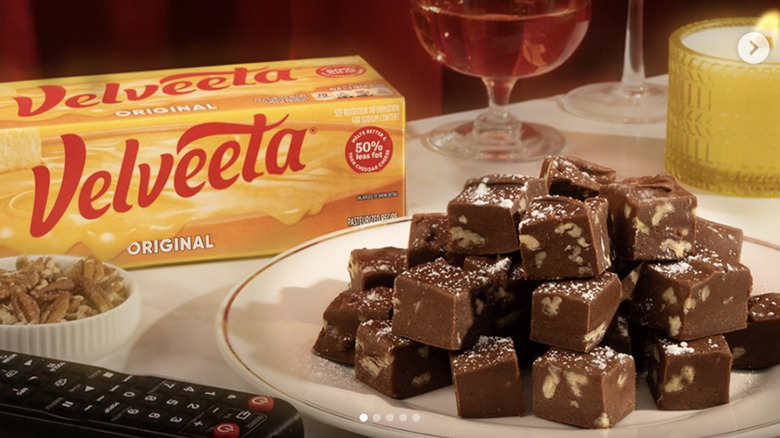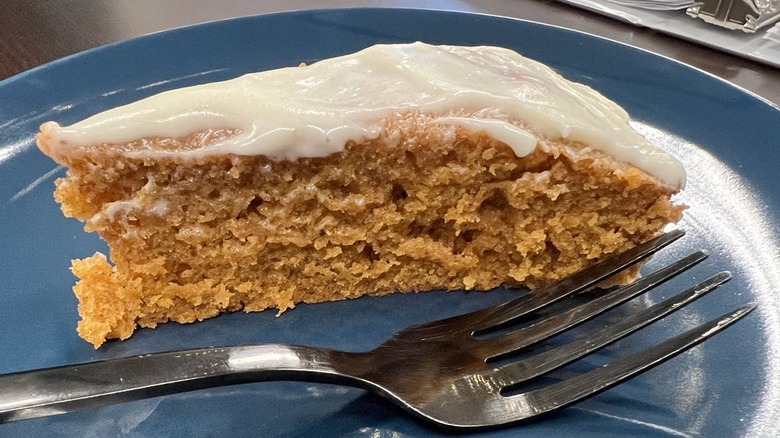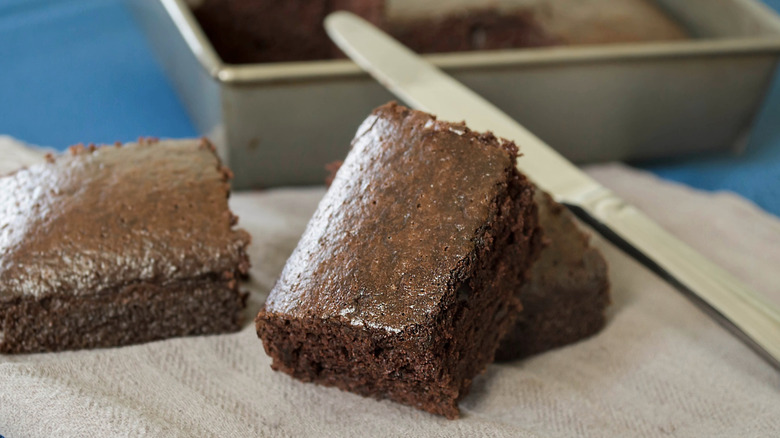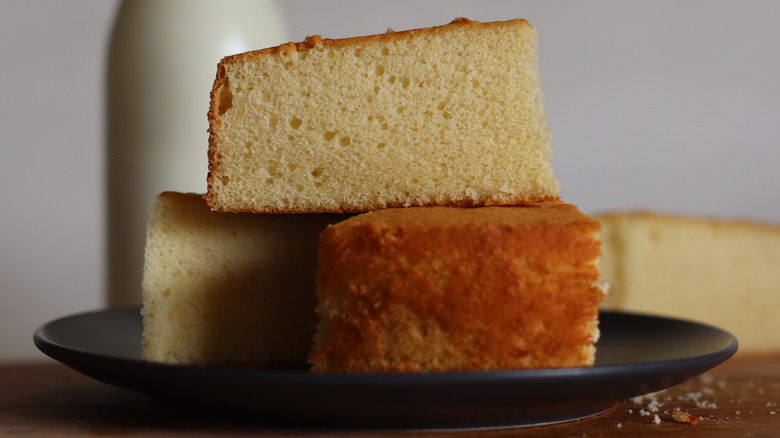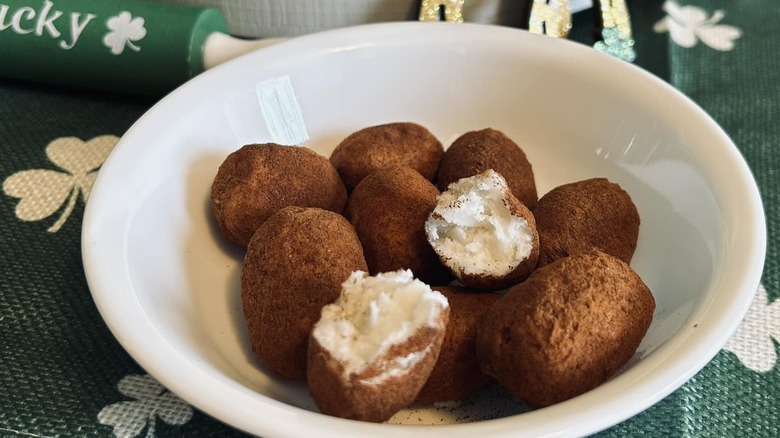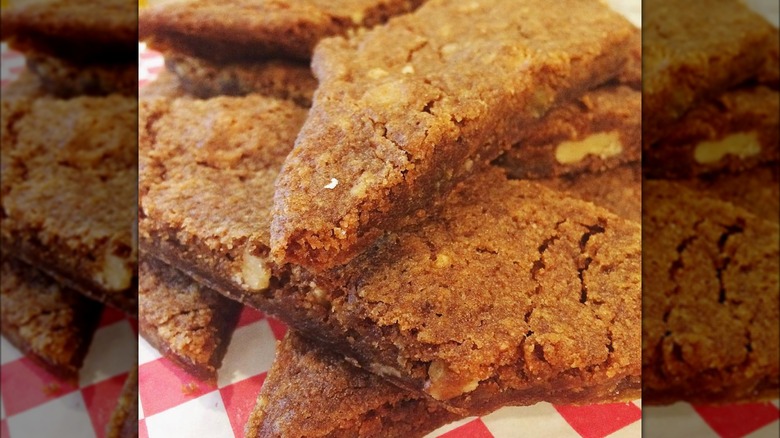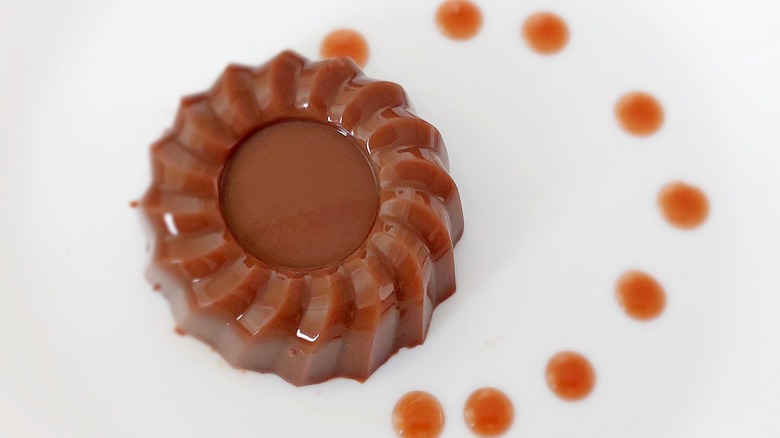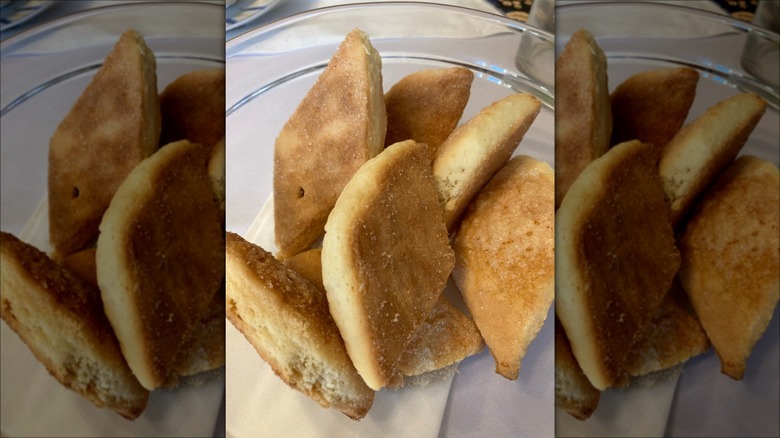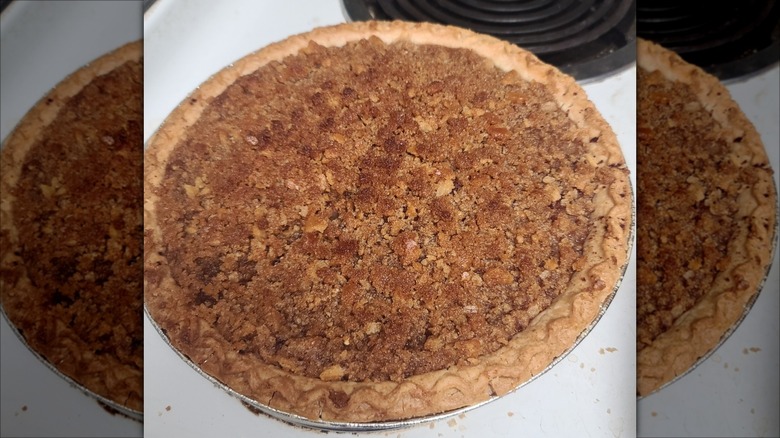13 Classic Desserts That Have Totally Vanished
Many of today's most popular foods didn't exist just a few generations ago. After all, plant-based burgers and açai bowls are relatively recent culinary phenomena. Conversely, many dishes that were once household names have vanished from modern menus. Recipes can lose popularity over time due to a range of factors, including changing tastes, lifestyles, and economic contexts. For instance, some dishes born out of scarcity, like the ration cake, lost their appeal once ingredients like milk, eggs, and butter became easily accessible again.
Ration cake isn't the only dessert that has faded into culinary obscurity. Other confections that were once beloved in the U.S. have gradually fallen out of favor. While these sweet treats may have once delighted our grandparents, their appeal has waned as dessert enthusiasts have increasingly sought out more decadent or visually striking options. Curious to find out what satisfied the sweet tooth of past generations? Take a look at our roundup of some classic desserts that have been lost to culinary history.
Chiffon pie
While they were hugely popular in the mid-20th century, chiffon pies have slowly become less relevant over the years. This could be due to the treat's light flavor and texture, with many sugar seekers today opting for richer dessert alternatives like cheesecakes and lava cakes. The chiffon pie was invented by Monroe Boston Strause – also known as the Pie King — in 1926 as a more modern, airy, and elegant alternative to heavy cream pies, which apparently reminded him of cornstarch pudding. When first invented, chiffon pies retailed for $0.35, the equivalent of around $5 today.
Often lemon-flavored, though also sometimes prepared in other variations such as pumpkin and orange, chiffon pie is made with whipped egg whites, which are folded into a sweet curd containing gelatin. The filling is then gently spooned into a crispy pie shell made from graham crackers and topped with whipped cream. This recipe was once so popular that Strause covered some 30,000 miles each year to pass on his pie-making technique to professionals in hotels and restaurants.
Oyster ice cream
If you thought that oyster ice cream was an American culinary myth, think again. The unlikely pairing made its debut in 1824 when a recipe for the dessert was documented in "The Virginia Housewife: Or, Methodical Cook" by Mary Randolph alongside other, more popular ice cream flavors, such as raspberry, strawberry, and chocolate. Randolph's version of the treat called for preparing a rich oyster soup — complete with cream, onions, eggs, flour, and lean ham — before straining and freezing it into a custard-like confection.
Oysters and ice cream go together like chalk and cheese — at least, in our opinion. Perhaps this is why the dessert didn't withstand the test of time. This, however, hasn't stopped oyster ice cream from popping up in culinary folklore. While urban legend claims that George Washington was a huge fan of the culinary curiosity and that Mark Twain references the dish in "The Adventures of Tom Sawyer," both tales are false.
More recently, in 2011, Chef José Andrés featured oyster ice cream at his now-shuttered America Eats Tavern in Washington, D.C. In an interview with NPR at the time, Andrés referred favorably to the dessert, saying, "You will get that cream, with the beautiful oyster salty, briny flavor."
Election cake
Election cake didn't get its name at random. The dessert was first served in New England in the 18th century to promote candidates during election time. Since women weren't allowed to vote at the time, the idea was that they could use these cakes to encourage men to vote for their preferred candidate. While it's unclear precisely when election cake was invented, the confection can be traced back to a dessert served by the early settlers who arrived in America from England.
The first recipe for an election cake was published in Amelia Simmons' "American Cookery" in 1796. At the time, the cakes tended to be rather hefty, normally clocking in at around 12 pounds. As such, it's not surprising that Simmons' recipe called for 30 quarts of flour, 14 pounds of sugar, 12 pounds of raisins, 10 pounds of butter, three dozen eggs, a pint of wine, and a quart of brandy. The recipe also made room for the dessert's defining feature: dried fruit and spices. By the 1820s, election cakes had diminished both in size and popularity, gradually slipping off the culinary radar.
Baked Alaska
If you've ever wondered how baked Alaska got its name, you may be surprised to learn that the dessert's moniker has nothing to do with its preparation method. Instead, it got its name as a tribute of sorts to America's acquisition of Alaska from Russia. If history isn't your strong suit, the U.S. purchased the land for $7.2 million — which equals just $0.02 per acre — in 1867.
Featuring ice cream and sponge cake encased in meringue, baked Alaska owes its existence to scientist Sir Benjamin Thompson, also known as Count Rumford, who discovered that whipped egg whites made a great insulator. This led to the creation of a dessert called omelette norvégienne by French chefs, a similar confection of ice cream and cake covered in warm meringue.
In 1867, a former Parisian pastry chef, Charles Ranhofer, who worked at the Delmonico's restaurant in New York City, commented on the country's recent acquisition of Alaska by including a version of omelette norvégienne on the menu. Called "Alaska, Florida," the dessert was meant to highlight the temperature contrast between its two components, just like the two states. While it's unclear when the Alaska, Florida became known as baked Alaska, the dessert already appeared under this name in Fannie Farmer's "Boston Cooking-School Cook Book" in 1896.
Velveeta fudge
Plenty of us have tried Velveeta cheese at one time or another. The Kraft product is made with milk, milk protein concentrate, whey, modified starch, canola oil, and cheese culture. Known for its intense orange color, Velveeta's smooth consistency when melted makes it a favorite addition to creamy dips, sauces, soups, and mac and cheese.
Back in the day, Velveeta was the star ingredient in Velveeta fudge. We can't be sure exactly when this treat was invented, but it's reflective of the mid-20th-century American enthusiasm for processed foods. The fudge in question combines Velveeta cheese with butter, sugar, cocoa powder, vanilla extract, and nuts. According to Reddit users, the flavor of Velveeta is so subtle in the recipe that it's hardly detectable, as highlighted by one of the platform's users, who wrote, "My grandpa used to make this. He acted like he was going to tell you a deep dark family secret and then he'd lean over and say, 'It's Velveeta!' and then pretend he was some sort of master chef. I personally think it's horrible."
Tomato soup cake
Canned tomato soup is a staple in many pantries. Affordable and shelf-stable, the dish is quick and easy to prepare on the fly. Tomato soup can also be used as a base for dishes like pasta and casserole. In a more unexpected application, tomato soup has also been added to cakes.
The recipe for tomato soup cake was likely developed at some point in the 1920s. While it hasn't been confirmed, we wouldn't be surprised if it were introduced by Campbell's to promote creative uses of its soup. Regardless, Campbell's didn't develop its version of the cake, Steamed Fruit and Nut Pudding, until the 1940s. The dessert was made with Campbell's condensed tomato soup, as well as figs, raisins, and nutmeats. Over the years, the company updated and renamed the recipe several times.
Tomato soup cake really came into its own in the 1930s and 1940s, a time when the Great Depression and World War II left families short on ingredients. The recipe evolved to include eggs and frosting in the 1950s, as Americans were once again able to afford a wider range of ingredients. Today, tomato soup cake is more of a nostalgic novelty, kept alive in cookbooks for those who want to recreate a vintage cake, than a go-to dessert for those with a sweet tooth.
Ration cake
If the idea of a ration cake sounds gloomy, its other two monikers — war cake and depression cake — won't exactly lighten the mood. As you can probably deduce from the name, ration cake traces its roots to culinary hardships when ingredients were either hard to come by or prohibitively expensive. When the government enforced food rations to help the war effort during World War II, home bakers had to improvise. Thus, the ration cake was born.
Standing as a testament to culinary ingenuity, ration cake was made without the basic ingredients we would all expect to appear in a homemade cake, such as butter, eggs, and milk. Instead, the dessert utilized substitutes. Vinegar and baking soda often replaced eggs, water stood in for milk, and lard, margarine, or bacon grease were used in the place of butter. Since white cane sugar could also be scarce, it was frequently replaced by dried fruits, brown sugar, honey, or molasses. Cinnamon, nutmeg, and cloves were also sometimes thrown into the mix.
Hot milk cake
As you can probably guess, hot milk cake gets its name from its method of preparation. The classic — yet somewhat outdated — dessert involves heating milk and butter and folding them into the batter. The other ingredients in the confection include eggs, sugar, flour, and baking powder. This light and airy sponge cake is relatively simple to prepare. For instance, there is no need to separate the eggs or measure the temperature of the butter and milk.
Recipes for hot milk cake first started appearing in print in the early 1900s, but the dessert really came into its own in the 1930s. Not only was the cake easy and quick to make, but it was also relatively inexpensive and versatile — both factors that made it a go-to treat for home bakers trying to make the most of limited ingredients. At the time, milk powder was often used as a substitute for its fresh counterpart.
While hot milk cake can be enjoyed on its own, it also makes a great base for toppings like fresh berries, whipped cream, and frosting. For instance, its spongy texture can be used to make Boston cream pie or Victoria sponge cake.
Potato candy
Talk about an unexpected pairing of ingredients — savory potatoes and sweet candy. One is used to make french fries and hash browns, and the other usually contains copious amounts of sugar or sweeteners. Nevertheless, when the two culinary opposites were first combined, they created a surprisingly delicious dessert.
While it's unclear when potato candy first came into existence, the confection became popular during the Great Depression due to its affordability. The recipes for this dessert vary, but it was typically made with just three ingredients: potatoes, peanut butter, and powdered sugar. Other recipes called for additions such as confectioners' sugar, shredded coconut, vanilla, and chocolate.
Interestingly, the recipe for Irish potato candy doesn't even contain spuds, nor does it have Irish origins. Created in Philadelphia, Pennsylvania, during the late 19th or early 20th century, likely by Irish immigrants, Irish potato candy is crafted by mixing cream cheese, sugar, butter, and coconut. The batter is then rolled into balls and coated with ground cinnamon.
Hermit cookies
Why are hermit cookies called hermit cookies? According to some accounts, it's because they keep for a long time before they go stale. In particular, they could be taken on long ship voyages by sailors and fishermen across New England's coast, where they were likely invented. As per Get the Good Stuff, The Republican explained the virtues of hermit cookies in 1888, writing, "This will keep for months, if out of humanity's reach, hence, perhaps their name."
Whatever the exact story behind their name, hermit cookies won themselves many fans thanks to their spiced and fruity flavor and chewy texture. Traditionally made in drop-cookie style, the dessert contains brown sugar, dried fruit such as raisins or currants, and spices including cinnamon, nutmeg, and cloves. They also sometimes included nuts, such as pecans or walnuts. Hermit cookies can also be made with molasses and sliced into bars after baking. This tweak in the recipe and preparation method gives the dessert a softer texture with chewy edges.
Blancmange
Blancmange is a more modern version of blanc mange, with a slight difference in spelling and recipe. Blanc mange, which translates to "white food" in French, was a medieval stew made with rice and almonds and served with either chicken or fish. Over time, blanc mange evolved into blancmange, a sweet dish with a creamy almond base. The first recipe for blancmange in its dessert form can be traced back to the early 17th century.
The recipe for blancmange continued to evolve, with the dish becoming particularly popular in Europe. Eventually, more color was added to the pudding. For example, saffron or egg yolks were added to the recipe to produce a yellow hue, spinach juice to give the dessert a green color, and cochineal to turn it red. In the 19th century, almonds disappeared from the confection, and gelatin replaced isinglass, a natural form of collagen made from the dried swim bladders of fish. While today's recipes for the sweet treat still vary, the panna cotta-like or firm pudding-like treat generally contains cornflour, milk, sugar, and flavoring such as vanilla, rosewater, or lemon.
Ammonia cookies
Ammonia cookies derive their name from their main ingredient, baker's ammonia. This was a leavening agent used in old-fashioned baking but was gradually replaced by baking soda and baking powder. While it was perfect for making light, crisp cookies, it wasn't ideal for softer baked goods. It also gave off a strong odor during baking, which made tasting the dough or opening the oven door during the baking process rather unpleasant. This is the reason why baker's ammonia, also known as ammonium carbonate, once doubled as smelling salts.
Rather than referencing one specific type of dessert, ammonia cookies encompass a range of traditional recipes that utilize the old-school ingredient. One of the most popular versions of ammonia cookies comes from Poland. Aside from baker's ammonia, ciasteczka amoniaczki consist of sour cream, flour, sugar, butter, eggs, and vanilla. While clearly past its heyday, baker's ammonia is still used in several other dessert recipes, including Swedish drömmar and Hungarian kvircedli.
Mock apple pie
Sometimes, necessity is the mother of invention. Mock apple pies became popular during World War II when apples became scarce and pricey, inspiring home bakers to get creative in the kitchen. As strange as this may seem, this led to a very unusual solution: using Ritz crackers as a stand-in for apples. Apparently, when broken into pieces and layered with lemon, sugar, and cinnamon, the crackers softened during the baking process, taking on the texture of baked apples.
While the star of mock apple pie is Ritz crackers, the recipe for the dessert predates the cracker itself. Ritz crackers first came on the market in the 1930s, while mock apple pie was already feeding dessert enthusiasts in the mid-19th century. The earliest recipe for the pie appeared in 1857, calling for bread crumbs in place of Ritz crackers. By 1869, many recipes featured soda crackers as the main ingredient in the dessert's filling.
The recipe for mock apple pie received an upgrade after Ritz crackers hit the store shelves, with many opting to include the buttery and flaky crackers in the apple-inspired filling. During the Great Depression, the National Biscuit Company (today known as Nabisco) even printed the recipe for the dessert on Ritz cracker boxes for easy reference.
